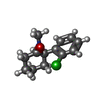[English] 日本語
 Yorodumi
Yorodumi- PDB-7eu8: Structure of the human GluN1-GluN2B NMDA receptor in complex with... -
+ Open data
Open data
- Basic information
Basic information
| Entry | Database: PDB / ID: 7eu8 | ||||||||||||||||||||||||||||||
|---|---|---|---|---|---|---|---|---|---|---|---|---|---|---|---|---|---|---|---|---|---|---|---|---|---|---|---|---|---|---|---|
| Title | Structure of the human GluN1-GluN2B NMDA receptor in complex with S-ketamine,glycine and glutamate | ||||||||||||||||||||||||||||||
 Components Components |
| ||||||||||||||||||||||||||||||
 Keywords Keywords | MEMBRANE PROTEIN / NMDA receptor / ketamine / enantiomer / rapid antidepressant / cryo-EM structure | ||||||||||||||||||||||||||||||
| Function / homology |  Function and homology information Function and homology informationglycine-gated cation channel activity / excitatory chemical synaptic transmission / Activated NTRK2 signals through FYN / Synaptic adhesion-like molecules / response to glycine / propylene metabolic process / negative regulation of dendritic spine maintenance / Assembly and cell surface presentation of NMDA receptors / regulation of monoatomic cation transmembrane transport / NMDA glutamate receptor activity ...glycine-gated cation channel activity / excitatory chemical synaptic transmission / Activated NTRK2 signals through FYN / Synaptic adhesion-like molecules / response to glycine / propylene metabolic process / negative regulation of dendritic spine maintenance / Assembly and cell surface presentation of NMDA receptors / regulation of monoatomic cation transmembrane transport / NMDA glutamate receptor activity / Neurexins and neuroligins / NMDA selective glutamate receptor complex / glutamate binding / ligand-gated sodium channel activity / neurotransmitter receptor complex / glutamate receptor signaling pathway / calcium ion transmembrane import into cytosol / protein heterotetramerization / glycine binding / positive regulation of reactive oxygen species biosynthetic process / monoatomic cation transmembrane transport / Negative regulation of NMDA receptor-mediated neuronal transmission / Unblocking of NMDA receptors, glutamate binding and activation / positive regulation of calcium ion transport into cytosol / Long-term potentiation / excitatory synapse / monoatomic ion channel complex / monoatomic cation transport / regulation of neuronal synaptic plasticity / positive regulation of excitatory postsynaptic potential / synaptic cleft / positive regulation of synaptic transmission, glutamatergic / calcium ion homeostasis / MECP2 regulates neuronal receptors and channels / glutamate-gated calcium ion channel activity / EPHB-mediated forward signaling / ligand-gated monoatomic ion channel activity involved in regulation of presynaptic membrane potential / ionotropic glutamate receptor signaling pathway / Ras activation upon Ca2+ influx through NMDA receptor / sodium ion transmembrane transport / synaptic membrane / regulation of membrane potential / transmitter-gated monoatomic ion channel activity involved in regulation of postsynaptic membrane potential / synaptic transmission, glutamatergic / excitatory postsynaptic potential / postsynaptic density membrane / brain development / visual learning / regulation of synaptic plasticity / calcium ion transmembrane transport / long-term synaptic potentiation / terminal bouton / synaptic vesicle / late endosome / signaling receptor activity / amyloid-beta binding / RAF/MAP kinase cascade / response to ethanol / dendritic spine / chemical synaptic transmission / postsynaptic membrane / learning or memory / cytoskeleton / calmodulin binding / lysosome / neuron projection / postsynaptic density / calcium ion binding / synapse / dendrite / endoplasmic reticulum membrane / protein-containing complex binding / cell surface / positive regulation of transcription by RNA polymerase II / zinc ion binding / plasma membrane / cytoplasm Similarity search - Function | ||||||||||||||||||||||||||||||
| Biological species |  Homo sapiens (human) Homo sapiens (human) | ||||||||||||||||||||||||||||||
| Method | ELECTRON MICROSCOPY / single particle reconstruction / cryo EM / Resolution: 4.07 Å | ||||||||||||||||||||||||||||||
 Authors Authors | Zhang, T. / Zhang, Y. / Zhu, S. | ||||||||||||||||||||||||||||||
| Funding support |  China, 9items China, 9items
| ||||||||||||||||||||||||||||||
 Citation Citation |  Journal: Nature / Year: 2021 Journal: Nature / Year: 2021Title: Structural basis of ketamine action on human NMDA receptors. Authors: Youyi Zhang / Fei Ye / Tongtong Zhang / Shiyun Lv / Liping Zhou / Daohai Du / He Lin / Fei Guo / Cheng Luo / Shujia Zhu /  Abstract: Ketamine is a non-competitive channel blocker of N-methyl-D-aspartate (NMDA) receptors. A single sub-anaesthetic dose of ketamine produces rapid (within hours) and long-lasting antidepressant effects ...Ketamine is a non-competitive channel blocker of N-methyl-D-aspartate (NMDA) receptors. A single sub-anaesthetic dose of ketamine produces rapid (within hours) and long-lasting antidepressant effects in patients who are resistant to other antidepressants. Ketamine is a racemic mixture of S- and R-ketamine enantiomers, with S-ketamine isomer being the more active antidepressant. Here we describe the cryo-electron microscope structures of human GluN1-GluN2A and GluN1-GluN2B NMDA receptors in complex with S-ketamine, glycine and glutamate. Both electron density maps uncovered the binding pocket for S-ketamine in the central vestibule between the channel gate and selectivity filter. Molecular dynamics simulation showed that S-ketamine moves between two distinct locations within the binding pocket. Two amino acids-leucine 642 on GluN2A (homologous to leucine 643 on GluN2B) and asparagine 616 on GluN1-were identified as key residues that form hydrophobic and hydrogen-bond interactions with ketamine, and mutations at these residues reduced the potency of ketamine in blocking NMDA receptor channel activity. These findings show structurally how ketamine binds to and acts on human NMDA receptors, and pave the way for the future development of ketamine-based antidepressants. | ||||||||||||||||||||||||||||||
| History |
|
- Structure visualization
Structure visualization
| Movie |
 Movie viewer Movie viewer |
|---|---|
| Structure viewer | Molecule:  Molmil Molmil Jmol/JSmol Jmol/JSmol |
- Downloads & links
Downloads & links
- Download
Download
| PDBx/mmCIF format |  7eu8.cif.gz 7eu8.cif.gz | 471.9 KB | Display |  PDBx/mmCIF format PDBx/mmCIF format |
|---|---|---|---|---|
| PDB format |  pdb7eu8.ent.gz pdb7eu8.ent.gz | 352.7 KB | Display |  PDB format PDB format |
| PDBx/mmJSON format |  7eu8.json.gz 7eu8.json.gz | Tree view |  PDBx/mmJSON format PDBx/mmJSON format | |
| Others |  Other downloads Other downloads |
-Validation report
| Summary document |  7eu8_validation.pdf.gz 7eu8_validation.pdf.gz | 888.7 KB | Display |  wwPDB validaton report wwPDB validaton report |
|---|---|---|---|---|
| Full document |  7eu8_full_validation.pdf.gz 7eu8_full_validation.pdf.gz | 899.3 KB | Display | |
| Data in XML |  7eu8_validation.xml.gz 7eu8_validation.xml.gz | 70.1 KB | Display | |
| Data in CIF |  7eu8_validation.cif.gz 7eu8_validation.cif.gz | 110.1 KB | Display | |
| Arichive directory |  https://data.pdbj.org/pub/pdb/validation_reports/eu/7eu8 https://data.pdbj.org/pub/pdb/validation_reports/eu/7eu8 ftp://data.pdbj.org/pub/pdb/validation_reports/eu/7eu8 ftp://data.pdbj.org/pub/pdb/validation_reports/eu/7eu8 | HTTPS FTP |
-Related structure data
| Related structure data |  31309MC  7eu7C M: map data used to model this data C: citing same article ( |
|---|---|
| Similar structure data |
- Links
Links
- Assembly
Assembly
| Deposited unit | 
|
|---|---|
| 1 |
|
- Components
Components
| #1: Protein | Mass: 95236.078 Da / Num. of mol.: 2 Source method: isolated from a genetically manipulated source Source: (gene. exp.)  Homo sapiens (human) / Gene: GRIN1, NMDAR1 / Cell line (production host): HEK293F / Production host: Homo sapiens (human) / Gene: GRIN1, NMDAR1 / Cell line (production host): HEK293F / Production host:  Homo sapiens (human) / References: UniProt: Q05586 Homo sapiens (human) / References: UniProt: Q05586#2: Protein | Mass: 96575.508 Da / Num. of mol.: 2 Source method: isolated from a genetically manipulated source Source: (gene. exp.)  Homo sapiens (human) / Gene: GRIN2B / Production host: Homo sapiens (human) / Gene: GRIN2B / Production host:  Homo sapiens (human) / References: UniProt: Q13224 Homo sapiens (human) / References: UniProt: Q13224#3: Sugar | ChemComp-NAG / #4: Chemical | ChemComp-JC9 / ( | Has ligand of interest | Y | Has protein modification | Y | |
|---|
-Experimental details
-Experiment
| Experiment | Method: ELECTRON MICROSCOPY |
|---|---|
| EM experiment | Aggregation state: PARTICLE / 3D reconstruction method: single particle reconstruction |
- Sample preparation
Sample preparation
| Component | Name: tetrameric complex of GluN1 and GluN2B subunits / Type: COMPLEX / Entity ID: #1-#2 / Source: RECOMBINANT |
|---|---|
| Molecular weight | Value: 383.22 kDa/nm / Experimental value: NO |
| Source (natural) | Organism:  Homo sapiens (human) Homo sapiens (human) |
| Source (recombinant) | Organism:  Homo sapiens (human) Homo sapiens (human) |
| Buffer solution | pH: 8 |
| Specimen | Embedding applied: NO / Shadowing applied: NO / Staining applied: NO / Vitrification applied: YES |
| Vitrification | Cryogen name: ETHANE |
- Electron microscopy imaging
Electron microscopy imaging
| Experimental equipment |  Model: Titan Krios / Image courtesy: FEI Company |
|---|---|
| Microscopy | Model: FEI TITAN KRIOS |
| Electron gun | Electron source:  FIELD EMISSION GUN / Accelerating voltage: 300 kV / Illumination mode: OTHER FIELD EMISSION GUN / Accelerating voltage: 300 kV / Illumination mode: OTHER |
| Electron lens | Mode: BRIGHT FIELD |
| Image recording | Electron dose: 60 e/Å2 / Film or detector model: GATAN K3 (6k x 4k) |
- Processing
Processing
| CTF correction | Type: PHASE FLIPPING AND AMPLITUDE CORRECTION |
|---|---|
| 3D reconstruction | Resolution: 4.07 Å / Resolution method: FSC 0.143 CUT-OFF / Num. of particles: 159306 / Symmetry type: POINT |
| Atomic model building | Protocol: RIGID BODY FIT / Space: REAL |
 Movie
Movie Controller
Controller



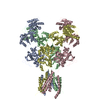




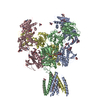
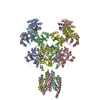

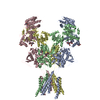
 PDBj
PDBj














